Der Merapi von der Nordseite
[Merapi from the north side]
[Merapi from the north side]
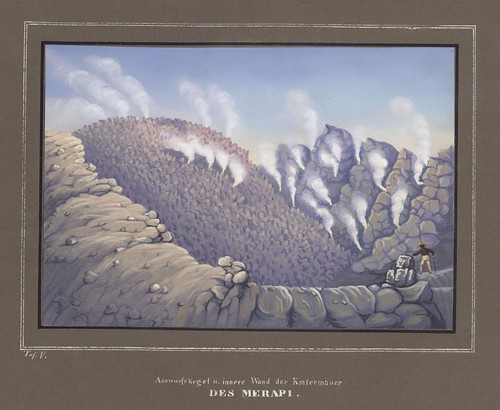
Auswurfskegel und innere Wand der Kratermauer des Merapi
[Ejection cone and inner wall of Merapi's crater]
[Ejection cone and inner wall of Merapi's crater]
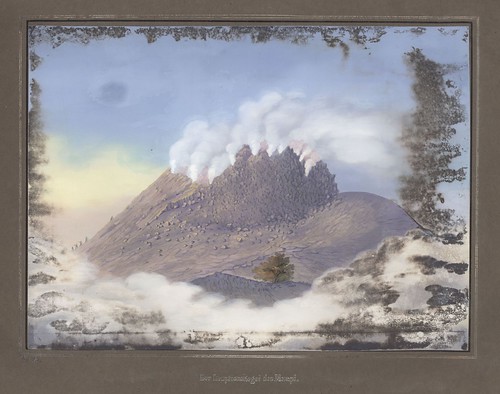
Der Eruptionskegel des Merapi
[Merapi erupting]
[Merapi erupting]
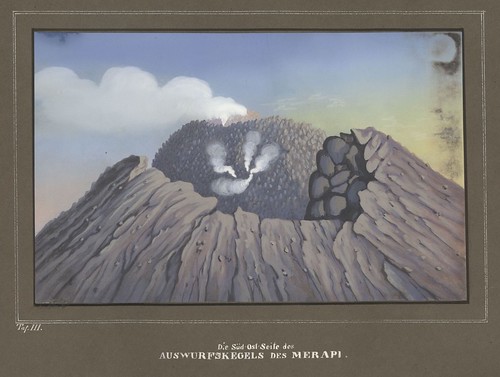
Die Süd-Ost-Seite des Auswurfskegels des Merapi
[The south-east side of the ejection cone of Merapi]
[The south-east side of the ejection cone of Merapi]

Merapi von der Südseite
[Merapi from the south side]
[Merapi from the south side]
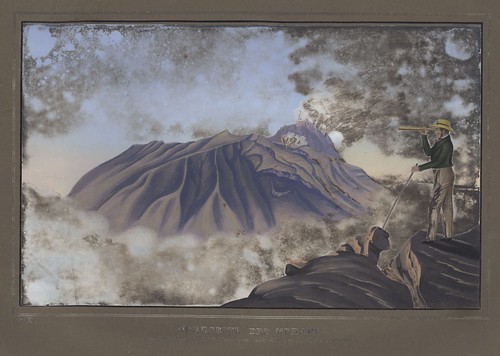
Nordseite des Merapi aus einer Höhe von 7500 Fuss vom südl. Abhange des Merbabu gesehen
[North side of Merapi from a height of 7500 feet from the south slopes of [Mount] Merbabu]
{that's Junghuhn with the telescope}
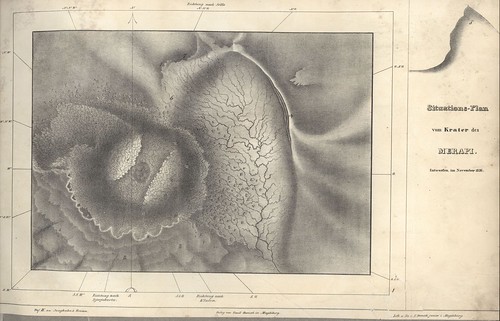
Situationsplan vom Krater des Merapi (November 1836)
[Schematic plan of Merapi crater]
[Schematic plan of Merapi crater]
View Larger Map
Also: see Flickr.
Standing some 9,500ft tall near the centre of the island of Java, Mount Merapi (Gunung Merapi - Mountain of fire) is the most active of the seventy-odd volcanoes that have erupted in Indonesia since 1900. [map]
"Typically, small eruptions [from Merapi] occur every two to three years, and larger ones every 10-15 years or so. Notable eruptions, often causing many deaths, have occurred in 1006, 1786, 1822, 1872 (the most violent eruption in recent history), and 1930 — when thirteen villages were destroyed and 1400 people killed by pyroclastic flows."The volcano became the visual centrepiece of a German book from 1845 called 'Topographische und naturwissenschaftliche Reisen durch Java' (Topographic and Scientific Journeys through Java). The lithographic plates were made by E. Baensch and, as far as I can tell, are not recording any specific (or at least significant) contemporary eruptions.
The book's author was an enigmatic character by the name of Franz Junghuhn (1809-1864). He overcame depression and a suicide attempt as a medical student, a prison sentence following a pistol duel (he escaped), and a stint in the French Foreign Legion on his path to becoming one of the foremost naturalists in 19th century Indonesia.
On the advice of a botanist friend, Junghuhn enlisted in the Dutch colonial forces as a doctor and shipped out to Batavia in 1835. He was renowned for being an individualist and was vocal in his dislike for following orders. He preferred the company of the natural world over humans. His medical tasks took a backseat to his interests in botany and field science and he was given the freedom by his superiors to go on many expeditions in Java because of his brilliance as a naturalist. He visited all the volcanoes of the island and conducted detailed surveys of the flora, geology and peoples of Java. He published a number of scientific works and a number of plant species are named after him.
Junghuhn had something of a scientific pantheistic belief system in which his God was to be found in all things and could be discovered through reason alone. On his scale, animals were at the bottom below green plants and fungae with rocks and mountains at the top and volcanoes the most important. To look into a crater, according to Junghuhn, was to see the face of God. He gave voice to this line of thinking in a 4-volume work that controversially included advocacy for a socialist Indonesia with a strident anti-Christian and anti-Islam tone. The work was banned in a number of European countries and the publisher of the first volume quit the project because of the uproar it caused. [The series is called 'Java, seine Gestalt, Pflanzendecke, und sein innerer Bau' (Images of Light and Shadow from Java's Interior), 1850-1854]
Late in his life Junghuhn was again involved in controversy when a public argument, played out in open letters with dissenters, occurred regarding the cultivation of Cinchona trees in Indonesia, which he advocated for their potential anti-malarial properties (quinine alkaloids). On his deathbed Junghuhn is said to have asked the doctor to open the windows so that he could say goodbye to his beloved volcanoes (Tangkuban Perahu was visible 30km away from his room in Bandung in West Java).
I didn't come across any biographies but I see screenplay written all over this.
- All the colour plates appearing in this post together with sectional plans of other Javanese volcanoes from 'Topographische und Naturwissenschaftliche Reisen Durch Java' are available in thumbnail format from the E-Doc server at Humboldt University.
- A microfilm scan of the complete 500+ page book is available from googlebooks.
- Biographical material: International Institute of Social History in Dutch [translation]; wikipedia. {the German wikipedia entry is extensive}
- Update: see this related later post.

Tempelruine Tjandi-sebu
ADDITION (24.2.10): Florent comments (and I think it's correct) that this plate is more likely a view of Candi Sewu, "an 8th-century Buddhist temple located 800 meters north of Prambanan in Central Java".




















14 comments :
Fascinating. Your opening illustration brings to mind Georgia O'Keefe.
Marvellous !
A bientôt
The strange life of Junghuhn will be a argument for a excelent Werner Herzog film.
Marvellous post, as usual.
Those are great. I agree that Junghuhn sounds like a natural for Herzog.
I wonder if there is anything similar illustrating Antarctica's Mount Erebus? Wikipedia has some gorgeous photos but due to all the snow I don't suppose there is quite the same potential for illustrations of its lava lake and (apparently ongoing) eruption. But I must say I'm more anxious to go to Java and see Merapi than to trek around Antarctica. For one thing, the music is better in Java. ;)
I have chosen your blog for the "I Love Your Blog" Award. Please see my post to learn more and grab the graphic, if you choose to display it on your blog.
I've read your blog a long time, and I'm sorry that I've never commented before.
http://creativeclown.com/index.php
I sent Mr Herzog a short message.
Zura thanks, sincerely. I'm not so much antisocial as umm ... marching to my own tune and trying to stay consistent: [link]
Great stuff, as always.
I'm sure you must have seen these but if you haven't…
http://www.ingenious.org.uk/See/?s=S1&ObjectID=%7B5262D81B-9B5D-7C7E-B327-B24C45AAE9C0%7D&source=Search&target=SeeMedium
Thanks MW! They're great.
I have indeed posted one image a couple of years ago from Campi Phlegraei (from Rylands library, Liverpool) but I don't believe I was aware of the whole of the Hamilton set being online. I will keep this link for a rainy day. Cheers!
Thank you very much, peacay.
I cannot help but add: Suicidal tendencies and volcanic craters make a perfect pair. It seems that Junghuhn observed the crater from a safe distance. (By the way: A literal English translation of Junghuhn would be "spring chicken".)
Merapi's eruption in 2006:
http://www.volcanodiscovery.com/volcano-tours/indonesia/merapi_special.html
Empedocles is said to have jumped into Etna's crater. Matthew Arnold's (1822-1888) poem, "Empedocles on Etna", is based on this story:
http://en.wikisource.org/wiki/Empedocles_on_Etna
More on "sulphur-stinking maw of death":
http://en.wikipedia.org/wiki/Kiyoko_Matsumoto
http://www.time.com/time/magazine/article/0,9171,748346,00.html
Gone out of context, perhaps. Apologies.
Wow. That is an astounding article. 1935. Amazingly odd writing too. *gobsmacked*
Greetings,
About the last plate on this post:
It is not a depiction of Borobodur, but almost without any doubt of another Buddhist temple complex in the Yogyakarta region, called Candi Sewu (pronounced Tjandi Séwu, and often spelled Tjandi Sébu in colonial era Dutch sources)
http://en.wikipedia.org/wiki/Candi_Sewu
I am an anthropologist specialised in Javanese culture and I've done fieldwork in the region of Yogyakarta.
Your blog is absolutely magical! keep up the good work!
Thanks very much Florent (and for the kind words) -- I've added a note above. I'm sure you're right.
Thanks very much for your fascinating account! I've been long interested in Junghuhn and am lucky to own some of his major works.
Indeed, his life is worthy of a screenplay: reckless student days, fighting duels, French legionaire, young botanist, colonial surgeon, intrepid traveler in the Indies, naturalist and humanist (n fact the founder of modern Dutch humanism)... etc.
You remark you don't know of any biographical work on him. Might I point you to (1909) M.C.P. Schmidt (in German), (1943/46) C.A. Wormser's romanticised biography (in Dutch), (1980 and following) the work by R. Nieuwenhuis and his collaborators (in Dutch). Excerpts from Junghuhn's works have also been translated into English.
With best wishes.
Arjo Vanderjagt
(arjovanderjagt@yahoo.com)
Thanks very much for the information Arjo.
Post a Comment
Comments are all moderated so don't waste your time spamming: they will never show up.
If you include ANY links that aren't pertinent to the blog post or discussion they will be deleted and a rash will break out in your underwear.
Also: please play the ball and not the person.
Note: only a member of this blog may post a comment.